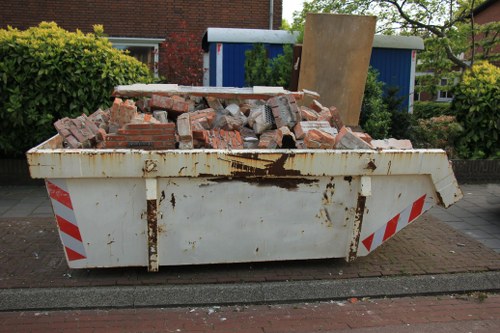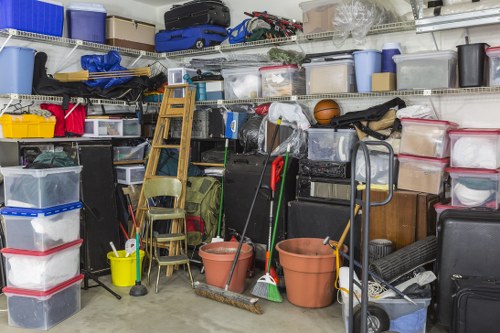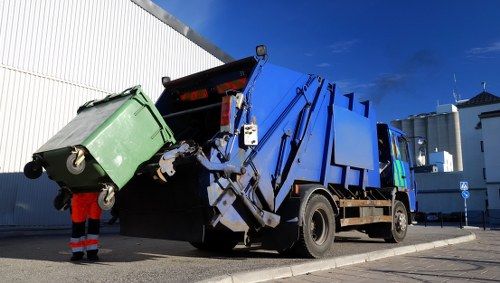Comprehensive Guide to Garden Clearance in Custom House

Managing a garden can be a fulfilling hobby, but there come times when you need professional help to clear it effectively. Whether you're preparing for a renovation, dealing with overgrown plants, or simply wanting to refresh your outdoor space, garden clearance services in Custom House are here to assist.
Garden clearance involves the removal of unwanted plants, debris, and other materials to ensure your garden remains healthy and aesthetically pleasing. It’s not just about tidying up; it’s about creating a space that you can enjoy and that adds value to your property.
In this guide, we will explore everything you need to know about garden clearance in Custom House, including the benefits, the process, and how to choose the right service for your needs.
Why Garden Clearance is Important

Maintaining a garden requires regular upkeep, and garden clearance plays a crucial role in this process. Here are some reasons why garden clearance is essential:
- Health of Plants: Removing dead or diseased plants helps prevent the spread of pests and diseases, ensuring the overall health of your garden.
- Safety: Overgrown vegetation can pose safety risks, especially in pathways and near structures. Clearing these areas reduces the risk of accidents.
- Enhances Aesthetics: A well-maintained garden looks more attractive and inviting, enhancing the overall appeal of your property.
- Prepares for New Growth: Clearing out old growth makes way for new plants and flowers, promoting a vibrant and lively garden.
By investing in regular garden clearance, you ensure that your outdoor space remains a place of beauty and relaxation.
Understanding the Garden Clearance Process

The garden clearance process involves several steps to ensure thorough and efficient clearing. Here’s what you can expect:
- Assessment: A professional will assess your garden to identify areas that need attention and discuss your specific requirements.
- Planning: Based on the assessment, a clear plan is developed outlining the tasks to be performed.
- Execution: This involves the actual removal of plants, debris, and any other unwanted materials. Tools and equipment are used to ensure the job is done efficiently.
- Clean-Up: After clearance, the area is cleaned thoroughly, and any recyclable or waste materials are disposed of responsibly.
- Final Inspection: A final check is conducted to ensure the garden meets the desired standards.
This structured approach ensures that every aspect of garden clearance is handled professionally.
Choosing the Right Garden Clearance Service

With numerous garden clearance services available in Custom House, selecting the right one can be challenging. Consider the following factors to make an informed decision:
- Experience: Look for companies with a proven track record and extensive experience in garden clearance.
- Reviews and Testimonials: Check online reviews and ask for testimonials to gauge customer satisfaction.
- Licensing and Insurance: Ensure the service provider is licensed and insured to protect yourself from any liabilities.
- Tools and Equipment: A reliable service will have the necessary tools and equipment to handle various garden clearance tasks.
- Environmental Responsibility: Choose a service that disposes of waste responsibly and considers environmentally friendly practices.
Taking the time to research and select the right garden clearance service ensures that your garden is in good hands.
Benefits of Professional Garden Clearance

Hiring professionals for garden clearance offers numerous advantages:
- Time-Saving: Professionals can complete the clearance quickly, allowing you to focus on other tasks.
- Expertise: Experienced gardeners know the best practices for clearing gardens without damaging existing plants.
- Proper Disposal: Professionals ensure that waste is disposed of correctly, adhering to local regulations.
- Safety: Clearing a garden can involve heavy lifting and the use of tools. Professionals are trained to handle these safely.
- Customized Services: Services can be tailored to meet your specific needs, whether it’s a complete clearance or targeted removal.
Costs Involved in Garden Clearance
The cost of garden clearance can vary based on several factors:
- Size of the Garden: Larger gardens require more time and resources, increasing the cost.
- Extent of Clearance: The amount of debris and the types of plants to be removed can affect pricing.
- Accessibility: Gardens that are hard to access may require special equipment, adding to the cost.
- Additional Services: Services like soil removal, composting, or landscaping can influence the overall price.
It’s advisable to get quotes from multiple service providers to compare prices and services offered.
Preparing Your Garden for Clearance
Proper preparation can make the garden clearance process smoother:
- Clear Pathways: Ensure that access points to your garden are clear to allow easy movement for the professionals.
- Identify Hazardous Areas: Point out any hazardous areas or specific concerns to the service provider beforehand.
- Remove Personal Items: Take down any personal items, garden furniture, or decorations that you don’t want to be moved.
- Communicate Your Needs: Clearly discuss your expectations and any specific instructions with the service provider.
These steps help in facilitating an efficient and effective garden clearance process.
Post-Clearance Garden Care
After the garden has been cleared, maintaining its condition is essential:
- Regular Weeding: Keep the garden free from unwanted weeds to maintain its appearance.
- Plant Maintenance: Regularly prune and care for your plants to ensure healthy growth.
- Seasonal Clean-Up: Perform seasonal garden clean-ups to prepare for changing weather conditions.
- Soil Care: Improve and maintain soil quality by adding compost or other nutrients as needed.
Ongoing maintenance helps in preserving the efforts made during the clearance and keeps your garden thriving.
Eco-Friendly Garden Clearance Practices
Adopting eco-friendly practices during garden clearance benefits both your garden and the environment:
- Composting: Compost green waste to create nutrient-rich soil for your garden.
- Recycling: Recycle materials like metal, glass, and certain plastics wherever possible.
- Natural Disposals: Use biodegradable bags for waste that can decompose naturally.
- Plant Preservation: Preserve healthy plants by relocating them instead of removing them.
Implementing these sustainable practices ensures that garden clearance is performed responsibly.
Common Challenges in Garden Clearance
While garden clearance is beneficial, it can present several challenges:
- Overgrown Vegetation: Thick growth can make clearance time-consuming and labor-intensive.
- Access Issues: Limited access to certain areas can complicate the clearance process.
- Persistent Weeds: Some weeds are difficult to remove and may require specialized treatment.
- Debris Disposal: Properly disposing of large amounts of green waste can be challenging.
- Time Constraints: Tight schedules can pressure the timeline for completing clearance tasks.
Understanding these challenges helps in planning and addressing them effectively during garden clearance.
Tools and Equipment Used in Garden Clearance
Professional garden clearance services utilize a variety of tools and equipment to ensure efficient and thorough clearing:
- Lawn Mowers: For trimming grass and clearing overgrown lawns.
- Brush Cutters: Used for cutting thick vegetation and weeds.
- Pruning Shears: For trimming and removing dead or overgrown branches.
- Wheelbarrows: To transport debris and waste efficiently.
- Chainsaws: For cutting larger branches and trees.
- Dustbins and Rubbish Bags: For collecting and disposing of waste.
Having the right tools ensures that the garden clearance is performed safely and effectively.
Seasonal Considerations for Garden Clearance
Different seasons bring unique challenges and opportunities for garden clearance:
- Spring: Ideal for clearing dead plants and preparing the garden for new growth.
- Summer: Focus on maintaining plants and managing growth during peak growing season.
- Autumn: Great for leaf removal and preparing the garden for winter.
- Winter: Clearing debris and protecting plants from harsh weather conditions.
Planning garden clearance around seasonal changes ensures that your garden remains healthy and vibrant throughout the year.
Local Regulations and Garden Clearance
When undertaking garden clearance in Custom House, it’s important to be aware of local regulations:
- Waste Disposal Laws: Ensure that garden waste is disposed of in accordance with local guidelines.
- Protected Plants: Some plants may be protected by law, and their removal might require special permissions.
- Noise Regulations: Be mindful of noise levels, especially when using power tools, to avoid disturbing neighbors.
- Building Codes: If clearance involves structures, ensure compliance with local building codes.
Adhering to these regulations helps in avoiding fines and ensures that garden clearance is conducted responsibly.
10-15 Nearby Areas to Custom House for Garden Clearance Services
Custom House is surrounded by several areas where you can find reliable garden clearance services. Here are some of the closest areas:
- East Ham: Just a short distance from Custom House, East Ham offers a variety of garden clearance professionals who understand the local environment.
- Wapping: Known for its scenic river views, Wapping has experienced gardeners who can handle both small and large clearance projects.
- Stratford: With its blend of residential and commercial properties, Stratford provides diverse garden clearance options.
- Canning Town: Canning Town’s garden clearance services are equipped to manage urban garden challenges effectively.
- Canary Wharf: High-rise gardens and small green spaces in Canary Wharf require specialized clearance services.
- Plaistow: Plaistow offers affordable garden clearance services, catering to various garden sizes and types.
- Barking: Residents of Barking can access professional garden clearance services that prioritize sustainability.
- Dagenham: Dagenham’s garden clearance experts are skilled in handling both domestic and commercial gardens.
- Ilford: Ilford provides comprehensive garden clearance services, including debris removal and plant trimming.
- Leyton: Leyton’s gardeners are known for their attention to detail and customer-focused services.
- Forest Gate: Forest Gate offers reliable garden clearance solutions tailored to individual needs.
- South Woodford: Garden clearance in South Woodford emphasizes eco-friendly practices and thorough clean-ups.
- Wanstead: Wanstead’s garden clearance services are adept at preserving the beauty and health of local gardens.
- Tower Hamlets: Serving the broader area, Tower Hamlets includes Custom House and offers extensive garden clearance options.
- Poplar: Poplar’s garden clearance professionals specialize in both residential and community gardens.
These nearby areas offer a range of garden clearance services to meet diverse needs, ensuring that residents of Custom House have access to quality assistance.
Tips for Maintaining a Cleared Garden
After a thorough garden clearance, maintaining the cleared space is essential. Here are some tips:
- Regular Maintenance: Schedule regular maintenance to keep your garden tidy and prevent overgrowth.
- Proper Watering: Ensure that plants receive adequate water to promote healthy growth.
- Mulching: Apply mulch to retain soil moisture and reduce weed growth.
- Pruning: Regularly prune plants to maintain their shape and encourage new growth.
- Pest Control: Monitor for pests and treat them promptly to protect your plants.
Consistent care helps sustain the benefits of garden clearance and keeps your outdoor space thriving.
When to Schedule Garden Clearance
Timing can significantly impact the effectiveness of garden clearance. Consider the following when scheduling your clearance:
- Seasonal Changes: Align clearance activities with seasonal transitions for optimal results.
- Weather Conditions: Choose a period with favorable weather to ensure efficient and safe clearance.
- Project Deadlines: If you have specific deadlines, plan clearance activities accordingly to ensure timely completion.
- Plant Growth Cycles: Schedule clearance during periods when plants are least likely to be stressed, promoting healthy recovery.
Strategic scheduling ensures that garden clearance is performed efficiently and supports the overall health of your garden.
DIY Garden Clearance vs. Professional Services
Deciding between DIY garden clearance and hiring professionals depends on several factors:
- Scale of the Project: Large gardens or heavily overgrown areas may be challenging to manage alone.
- Expertise: Professionals bring experience and knowledge that can lead to better results.
- Time Investment: DIY clearance can be time-consuming, whereas professionals can complete the job more quickly.
- Tools and Equipment: Professionals have access to specialized tools that may not be readily available for DIY projects.
- Cost: While DIY might seem cheaper initially, the cost of tools and potential mistakes can add up.
Assessing your specific needs and resources will help you make the best decision for your garden clearance.
Conclusion
Garden clearance is a vital aspect of maintaining a healthy and visually appealing outdoor space. In Custom House, a range of professional services are available to help you manage and enhance your garden effectively.
By understanding the importance of garden clearance, the processes involved, and how to choose the right service, you can ensure that your garden remains a place of beauty and relaxation. Whether you opt for professional help or decide to undertake clearance yourself, the key is consistent and thoughtful maintenance.
Investing in garden clearance not only improves the health and appearance of your garden but also adds value to your property, making it a worthwhile endeavor for any homeowner.
Frequently Asked Questions
1. How often should I have my garden cleared?
It is recommended to have your garden cleared at least once a year, preferably during spring or autumn, to maintain its health and appearance. However, the frequency may vary based on the size and condition of your garden.
2. Can garden clearance help prevent plant diseases?
Yes, regular garden clearance helps remove dead or diseased plants, reducing the risk of pests and diseases spreading to healthy plants.
3. What should I do with the waste generated from garden clearance?
Garden waste should be disposed of responsibly. Many professional garden clearance services offer waste removal and recycling options. Alternatively, you can compost the green waste or take it to a local recycling center.
4. Is garden clearance expensive?
The cost of garden clearance depends on factors such as the size of the garden, the extent of clearance needed, and the specific services required. It is advisable to obtain quotes from multiple providers to find a service that fits your budget.
5. Do I need to be present during the garden clearance?
While it is not always necessary to be present, it is beneficial to be available to discuss your specific needs and preferences with the service provider to ensure the clearance meets your expectations.